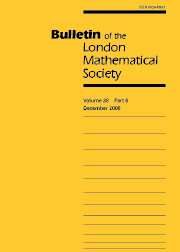Article contents
${\rm C}^*$-ALGEBRAS WITH DENSE NILPOTENT SUBALGEBRAS
Published online by Cambridge University Press: 12 May 2003
Abstract
In a beautiful result, Herrero (D. A. Herrero, ‘Normal limits of nilpotent operators’, Indiana Univ. Math. J. 23 (1973/74) 1097–1108) showed that a normal operator on $l^2$ lies in the closure of the set of nilpotent operators if and only if its spectrum is connected and contains zero. In the quest for an automatic continuity result for algebra homomorphisms between ${\rm C}^*$-algebras, Dales showed that, if a discontinuous algebra homomorphism $\theta :{\cal A} \rightarrow {\cal U}$ exists between ${\rm C}^*$-algebras ${\cal A}$ and ${\cal U}$, and if $\theta({\cal A})$ is dense in ${\cal U}$, then there is a ${\rm C}^*$-algebra ${\cal U}_2$ with a dense subalgebra ${\cal N} \subset {\cal U}_2$ such that every $x \in {\cal N}$ is quasinilpotent (see p. 685 of H. G. Dales, Banach algebras and automatic continuity, London Mathematical Society Monographs 24, Oxford University Press, 2001). (A discontinuous homomorphism $\theta_2 :{\cal A}_2 \rightarrow {\cal U}_2$ can be defined with the same basic properties as $\theta$, but the revised target space ${\cal U}_2$ has a dense subalgebra consisting of quasinilpotent elements.) As remarked by Dales, no such ${\rm C}^*$-algebra was then known; but here we present one. Indeed, using the full power of Herrero's result, one may arrange that every $x \in {\cal N}$ is nilpotent. The ${\rm C}^*$-algebra is constructed in a ‘neat’ way; it is most naturally constructed as a non-separable, concrete ${\rm C}^*$-algebra of operators on a separable Hilbert space ${\cal K}$; but one can arrange that the algebra ${\cal U}$ itself be separable if desired.
- Type
- Research Article
- Information
- Copyright
- © The London Mathematical Society 2003
- 1
- Cited by




